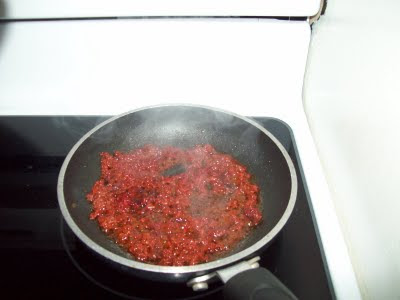
Heirlooms are not necessarily all "things". Plants can be heirlooms too, preserved and passed down for future generations to be able to grow, whether by division or through seed.
My mother has always collected flowers and flower seeds - most of the plants in her lovely yard were "starts" from friends and neighbors, or seed she collected from abandoned places.
Part of my gardening this year was done on borrowed ground. My friend, Maxine Carter, who let me use her plot also shared her Okra seed with me. She said that the man they bought the property from back in the mid 1970's, a Mr Bird, gave them this seed at that time and that she has grown it and saved the seed ever since.

It is like no okra I have ever seen. The optimim size for picking is about 4 inches long... and 1 1/4" to 1 1/2" diameter! It is huge! And tender as can be even at that stage.
While it is tender, it will "snap" off the stalk. If it bends when you try to pluck it, it has gotten woody. I just leave those pods attached to make new seed.
After picking, it keeps best at room temp where there is good air flow - turned over daily in a basket or paper sack, or laid out in a single layer. It will keep several days like that.
The ones left on the stalk for seed can stay on the stalk until the completely dry and start to pop open. That it when I cut them off (takes a knife), and lay them out in a single layer to dry completely. There is still a lot of water in them at this stage so it can take a month or so for them to dry. You can then store the seed right in the dried pods. The alternative would be to shell the seeds out of them and then dry the seeds in your dehydrator at a low temp (120 or lower) before storing in paper bags. The seed will be viable for many years if stored in a dark, dry location.
My friend said that she has never seen anything like it either, and she has always called it "Big Fat Okra".


Paul says it tastes better than any okra he has had before too. It also freezes and cans beautifully. I just slice it up and vacuum pack it to freeze, or can it in my pressure canner with tomatoes, onions and, if you like, corn - okra MUST be pressure canned. A water bath is NOT safe for canning okra. Please see the directions at the
National Center for Home Food Preservation.
We saved seed again for her to have plenty, and I brought some home to add to my heritage as well. So kids, when you find okra seed in with my stuff in about 50 years, you'll know where it came from! LOL!
UPDATE 09/04/14 I finally discovered where this came from. It was not Mr Bird, but Charles Wright who developed this interesting variety of okra at Blanket, Brown County, Texas. Mr Wright was a high school Science teacher in Blanket. Among other things, he and his wife grew a large garden each year for the benefit of the community - a local lady said everyone was invited to go pick what they could use, and expected to leave enough for others. It was he who developed this okra. Most local people had forgotten his connection with it, and his grandchildren didn't have any information about it, or even any of the seed. I've printed some seed packets to share around town and help preserve this little portion of Mr Charles Wright's legacy.
My neighbor Mike Caldwell told me that Charles Wright developed this, and that they had also called it "Pot Belly Okra". Mike reminisced about the massive height of the stalks and the root system. The plants branch out like trees, so that one plant will produce, at the height of the season when it has matured, several pods a day.
The stalks will grow to 8 or 9 feet tall. I just pull them over to pick then let go and they pop back up. You might could prune them, because of their natural branching habit, but I have not tried that yet.
They will continue producing here in North Central Texas until the plants are killed by frost.
UPDATE 09/2015 I've since been sharing the seed for this okra around the country. I am eager to hear how it grows in other parts of the country. At this point, I feel comfortable that at least the seed is no longer in quite the danger of being lost as it was when I became the unlikely recipient of some of the last remaining seed. It makes me happy that I got interested enough to keep asking people until I ran into someone who knew its history!



















































